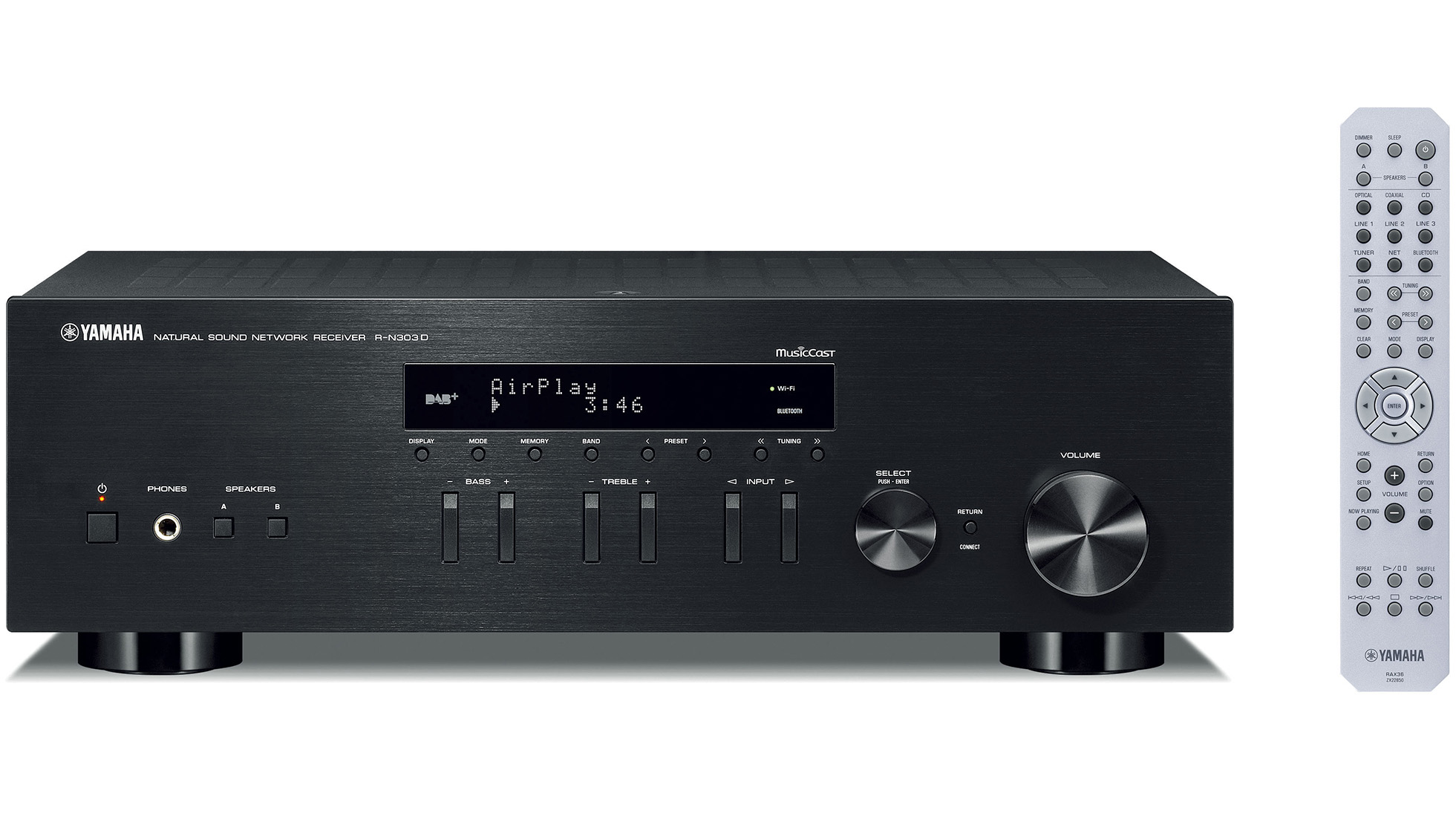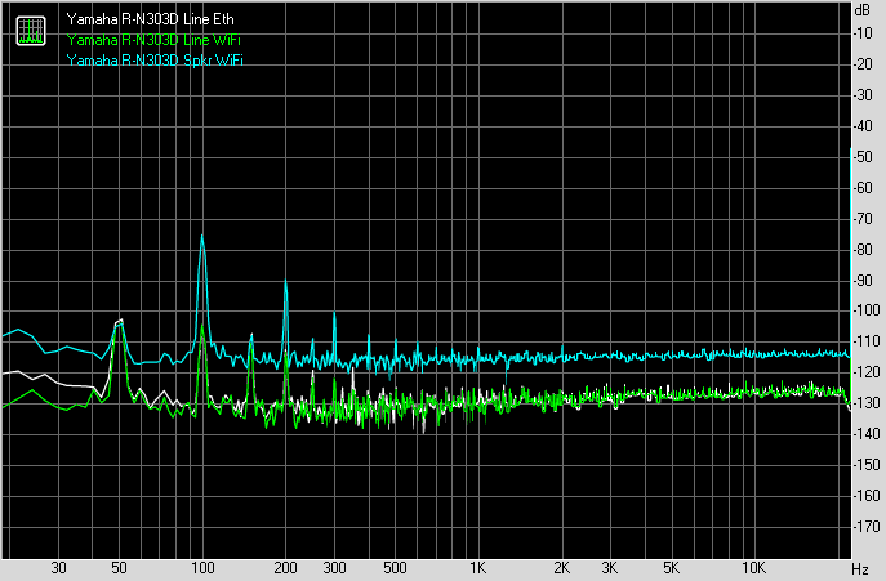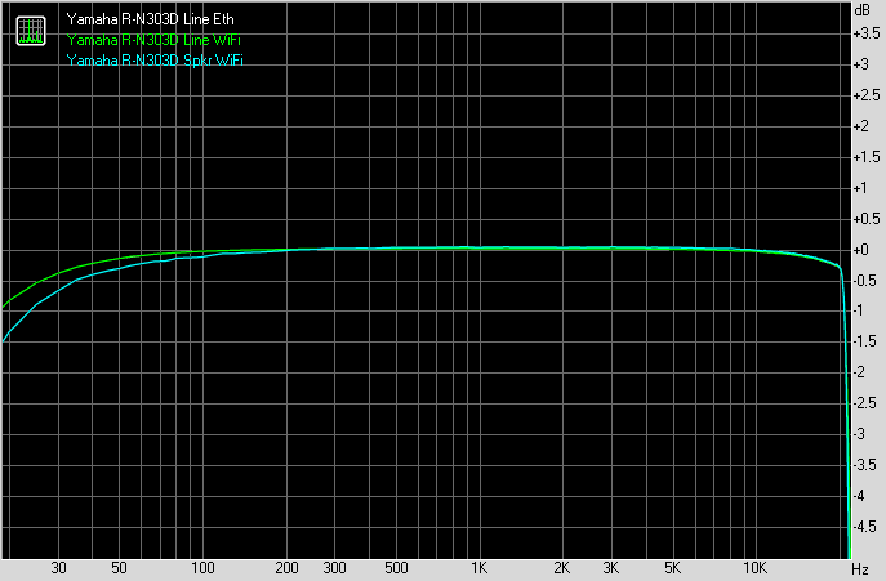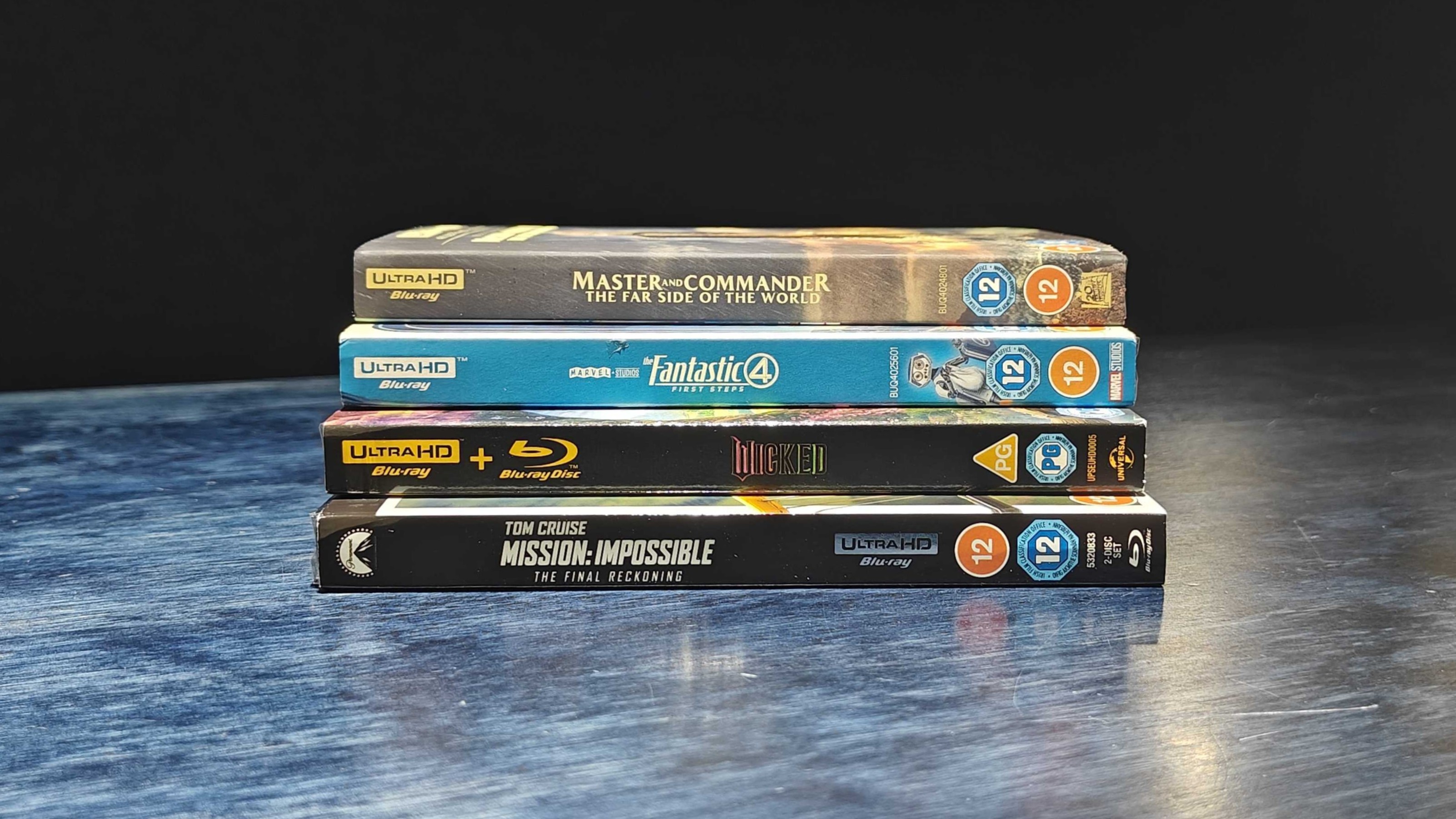What Hi-Fi? Verdict
With networked and internet music plus radio tuners on top of a solid little stereo amplifier, this is an impressively-priced system solution.
Pros
- +
Solid hi-fi sound at the price
- +
MusicCast networking / streaming
- +
Good selection of inputs
Cons
- -
No phono stage or USB-B
- -
Ultimate limits on power
Why you can trust What Hi-Fi?

This review and test originally appeared in Australian Hi-Fi magazine, one of What Hi-Fi?’s sister titles from Down Under. Click here for more information about Australian Hi-Fi, including links to buy individual digital editions and details on how best to subscribe.
The Yamaha R-N303D stereo receiver takes me ‘way, ‘way back. Back to when I was a poor student with a love of stereo, but with limited finances to indulge it. Everything was analogue back then, but the analogous cash-strapped student of today would surely want a mix of analogue and digital. The Yamaha R-N303D stereo receiver does both very nicely.
Equipment
I think about the Yamaha R-N303D in this way: take a modern, networked home theatre receiver and eliminate anything and everything beyond what’s required for stereo music. I know audiophiles are not keen on home theatre receivers but in practice they provide lot of performance for the money. In this case, the things dropped are anything to do with video, all the extra power amplifiers, and all the digital processing.
What the Yamaha R-N303D offers is analogue stereo power output of 100-watts per channel into 8Ω, four line-level analogue inputs, coaxial and optical digital audio inputs, Ethernet and Wi-Fi for network streaming, and Bluetooth, plus an FM/DAB+ tuner, all in a clean, if somewhat boxy, design.
My review unit had a brushed aluminium face, but black is also available. The front panel is also adorned with a display to show information such as current input selection, plus a menu for setting things up. A neat infrared remote control lets you control things from a distance.
At its low recommended retail price and with a wide feature set, you could expect some compromises, of which the Yamaha R-N303D stereo receiver has several. The power rating, for example, is for the frequency range from 40Hz to 20kHz, not from the more traditional 20Hz. And the power is referenced with a THD limit of 0.2%, rather than the more typical sub-0.1% rating.
Furthermore – and this may be a real limitation – Yamaha cautions that the nominal impedance of connected speakers should be at least 8Ω. And if you’re planning to have both the A and B speaker outputs running at the same time, the speakers should be 16Ω. Since there’s virtually nothing on the market with such a high impedance, it would probably have been better for the receiver to have had a switch that selects between the two, rather than two buttons it does have, which can be engaged simultaneously.
There are two possibly significant omissions. The first is that the analogue inputs are all line-level. Which is to say, to play vinyl you will need to buy an external phono preamplifier, or use a turntable with a built-in phono preamp. The latter are increasingly common, along with those with USB outputs, so perhaps it was worth the cost savings.
The latest hi-fi, home cinema and tech news, reviews, buying advice and deals, direct to your inbox.
The second is that there is no line-level subwoofer output. That won’t bother many, but one route to good-quality sound at a low price is to couple a pair of high-quality compact speakers with a subwoofer.
Network and Bluetooth
A single antenna on the back is provided for both Wi-Fi and Bluetooth. The Wi-Fi supports standards up to 802.11n and runs on the 2.4GHz band only. If you have an Ethernet cable point handy, it could be worth connecting that way if only to reduce the crowding on the 2.4GHz channels.
The Bluetooth is fairly basic, running version 2.1+EDR. These days Bluetooth is up to version 5.1. For stereo music, the two codecs on offer are SBC – which is supported by everything that can do stereo – and AAC, which is generally supported by Apple devices, along with a smaller number of Android phones.
On the network front, the receiver works with Yamaha’s MusicCast multi-room system. The main way that you’ll send music to it is using the MusicCast app (on Android and iOS). You can use the app effectively as a remote control, selecting inputs, tuning radio stations and choosing from amongst the network audio offerings supported by the app.
These include Pandora (which isn’t available in Australia), Deezer, Spotify, TIDAL and Internet radio. For Spotify and TIDAL and (I think) Deezer, you need a subscription. The MusicCast app invokes the Spotify app when you choose that service, and it directly interfaces with TIDAL music.
With Spotify, you change the speaker once you’re in the app to the Yamaha receiver. TIDAL’s own app could not see the Yamaha receiver, which is a pity. The MusicCast app playing back TIDAL music was not gapless. Indeed, there were gaps several seconds long between what should have been the run-on tracks in Marillion’s ‘Misplaced Childhood’.
One workaround I used was to use the TIDAL app on an iPhone and then use AirPlay to send the music to the Yamaha R-N303D. But doing that results in lower quality than regular TIDAL. And that album is a “Master” on TIDAL, decoding to a lossless 96kHz sampling. The Yamaha R-N303D receiver can’t do the necessary unpacking.
The receiver also supports digital audio streamed from local network sources. It worked with my FLAC content at up to 192kHz as well as double-rate DSD (ie. DSD128). The handling by the MusiCast app was quite elegant, with a clean screen layout.
Listening sessions
I did almost all my listening with three sources, only one of them external to the Yamaha R-N303D receiver. The two internal sources were its DAB+ tuner and its network playback capabilities. For the latter, I mostly used TIDAL as the source, except when there were lots of run-on tracks. The insertion of gaps made listening to those too frustrating. The firmware on my review sample was Version 1.18. It may be that this issue can be rectified by a firmware update.
The other source was a turntable. But which turntable? Somehow my Rega Planar 3/Moon 110LP v2 phono preamplifier combo seemed a little too much for a receiver like the Yamaha R-N303D. A better match was the new Audio-Technica AT-LP120XBT-USB turntable. Forget about the BT and USB stuff. It still has an analogue output, with a switchable phono pre-amp. With the AT-VM95E cartridge, it’s priced identically to the Yamaha R-N303D receiver. The speakers I used were a pair of KEF R300 three-ways. They’re large bookshelf-size models, and good down to 40Hz.
The network audio performance was excellent – aside from that irritating TIDAL gap– on just about everything. Streaming the Prelude to Delibes’ ‘Lakmé’ (Mesplé, Burles on EMI), the opening brass and percussive blast was solid and powerful, carrying through to the point where the bass drum entered the mix. The strings were smooth over to the left side of the stage while there remained plenty of air surrounding the instruments.
Streaming Indiscipline from the 24/96 2011 remaster of King Crimson’s ‘Discipline’ resulted in a powerful, controlled and very engaging delivery. Bruford’s drums danced over the top of the mix. The sound of Levin’s Chapman Stick was solid and extended and decent control over proceedings was maintained by the receiver.

I found myself almost unreasonably enjoying the performance of the receiver when playing vinyl. For example, the ridiculous insertion of harpsichord into the rock rendition of Dance of the Little Fairies on the 1980 album ‘Sky 2’ simply worked, and seemed not at all out of place with a drum performance that seemed to have bypassed the engineering suite’s limiters.
The bass kick was a touch soft, but given the solid bass performance with the digital material, I suspect that’s due to the common vinyl bass reductions (got to fit that 18 to 25 minutes on a side, after all!) The thing about harpsichords and drum kits both is the importance of transients to their delivery. The Yamaha R-N303D was up to the task. Easily.
Background detail was there in abundance, along with a decent amount of space.
The reverberant air around – again – the drum kit in Sahara, on the same side of the same album, was very satisfying. That was an early pressing – made in Sydney in or soon after 1980 – that I bought new back in the day. Hey, AU$9.99 for a double album from a now long-defunct record shop!
Moving into this millennium, Laura Marling’s ‘Once I Was an Eagle’ is a fine acoustic work, released in 2013. The analogue version has the 63 minutes split over four sides on heavy vinyl and this was pressed in the EU. I am more used to the CD version. Played analogue on this combo, the upper bass of the tom-tom – hand-struck I’d guess – was fuller and more reverberant. But her close-miked voice had the same slightly in-your-face impact. Stereo imaging of the various elements was precise, with modest depth.
There wasn’t quite the magic delivered by my main system. But there was a decent representation of the music. Best of all, there was plenty of good clean fun.
Final verdict
If I were once again a student in a room in Glebe, I would have given just about anything for a system based around this Yamaha R-N303D stereo receiver, especially if it were coupled with some half-way decent 8Ω speakers. Thanks to the network audio and DAB+/FM being built in, all you need to add are those speakers and you’ll have a vey good-sounding, cost-effective hi-fi system.
Lab test results
So, does the Yamaha R-N303D actually deliver 100-watts of power per channel?
I test power output at three frequencies – 100Hz, 1kHz and 10kHz – and push up sine wave levels until just before there’s any visible flattening or instability shown on the oscilloscope.
At 100Hz the Yamaha R-N303D receiver pushed out 107-watts into 8Ω. At 1kHz it increased slightly to 110-watts, while at 10kHz it fell back to 94-watts. Of course, no consumer audio amplifier is ever called upon to deliver even one watt at 10kHz, so in terms of power, the amplifier is well and truly satisfactory.
I had not studied the manual before I ran these measurements, so I blithely connected the receiver up to 4Ω test loads and re-ran the power output tests. At 100Hz, 1kHz and 10kHz, the receiver delivered 132-watts, 136-watts and 146-watts respectively. Why the increase at 10kHz? No idea… but it may be concerned with Yamaha’s admonition to use 8Ω rather than 4Ω speakers.
We must remember not to get too hung up about what appear to be marked differences in power measurements, of course. Remember, all six of those figures are between 19.7dB and 21.7dB above one watt, so there’s less than 2dB difference between them.
I did not have high hopes for the performance of the headphone output and was consequently not surprised by its results. Clearly, the headphone output is supplied by the main amplifier with an in-line resistor of around 460Ω. That was not a problem as far as power output goes. Into a 16Ω load, the receiver could deliver more than 80mW, and into a 300Ω load, that went up to a massive 640mW. These output levels are, respectively, 19dB and 28dB above the usual 1mW sensitivity rating of headphones.
The problem isn’t power, it’s that the in-line resistance makes the output voltage level vary according to load impedance. Some headphones – planar magnetic designs for one – have a more-or-less even impedance across their frequency range, but the impedance of many headphones varies widely. The latter will have a frequency balance that mirrors the impedance curve, which makes performance quite unpredictable.
I ran the usual suite of noise, distortion and frequency response tests… twice. The first time I measured at the line level outputs. Note, these are not pre-amp outputs as such. They are fixed in level, more akin to the tape outputs of amplifiers of old. You could use these to feed some other device, but you’d need to have a volume control on that device. As we will see, I wish Yamaha had seen fit to include preamplifier outputs on this unit. It would make for a nice upgrade path with the addition of a higher quality power amplifier.
The second set of measurements was at the speaker outputs, each driving a 8Ω resistive load with the output level set for one watt of output with a 1kHz signal peaking at 0dBFS.
So, let’s start with noise performance at line level. Over the years, I have found that many digital devices are unfortunately susceptible to noise coming over the Ethernet connection, so I measured with Ethernet connected, and without, using Wi-Fi instead for feeding the test signals.
The unit delivered a respectable –104dB, A-weighted, noise level with 24-bit signals when using Ethernet.
The improvement via Wi-Fi was only slight: –105dB. The Ethernet added a bit more deep bass noise, up to 10dB at 20Hz, and a few midrange, treble and ultrasonic spikes. But none of those spikes made even –110dB, and most were close to –130dB. That is, absolutely inaudible.
The main reason the noise level was –104dB rather than –114dB was breakthrough of 50Hz mains noise, along with its harmonics. None of these reached beyond –100dB. For all practical purposes, they also were inaudible. (When you look at the graphs, ignore the hump above 50kHz. That seems to be due to the ADC’s oversampling and noise-shaping operations.)
This is all shown in Graph 1, along with the equivalent measurement at the speaker terminals. The noise level in that measurement was –82dB(A). I certainly couldn’t hear any noise on program material, so I suspect that also is below the level of perception. (A system turned up to one watt peak output is actually surprisingly loud.)
Graph 2 repeats the same test, but with 16-bit audio. There was still a difference between line and speaker outputs. The line level managed an impressive –97.1dB, pretty much in the top tier of performers. At the speaker outputs, this fell away to –81.9dB.
At the line output, THD was less than 0.002%, although it was 0.036% at the speaker outputs. IMD was around 0.0035% at the line outputs, but substantially higher at 0.12% at the speaker outputs.
The frequency response was quite interesting. Let’s consider the response when the receiver is fed 192kHz-sampled signals, as shown in Graph 3. All DACs exhibit a high frequency roll-off to some extent. With this receiver, it comes a bit earlier and more steeply than usual. At 20kHz the output is down by 0.2dB – a trivial amount. But it’s down by 1dB at 30kHz, 3dB at 42kHz and 6dB at 55kHz.
I am inclined to think that it matters not a whit, but if you’re after an extended ultra high-frequency response, you may be disappointed. With 16-bit and 44.1kHz sampling (Graph 4), the response is the same up to a hard cut-off shortly before the Nyquist frequency in both cases.
(I must confess at this point, I do love living in a time when I’m slightly criticising an affordable stereo receiver for being down by a likely inaudible 0.2dB at 20kHz!)
The graphed response at the bass end seems to validate Yamaha’s relatively restricted power output claims. Via the line output, its level was down by 0.5dB at 30Hz, and 1dB down at 20Hz. Via the speaker outputs, the bass was down a little further at 20Hz, but only by an extra 0.5dB.
Australian Hi-Fi is one of What Hi-Fi?’s sister titles from Down Under and Australia’s longest-running and most successful hi-fi magazines, having been in continuous publication since 1969. Now edited by What Hi-Fi?'s Becky Roberts, every issue is packed with authoritative reviews of hi-fi equipment ranging from portables to state-of-the-art audiophile systems (and everything in between), information on new product launches, and ‘how-to’ articles to help you get the best quality sound for your home.
Click here for more information about Australian Hi-Fi, including links to buy individual digital editions and details on how best to subscribe.







